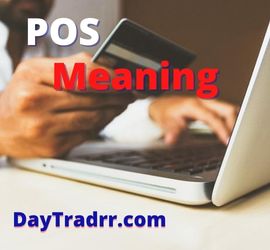POS Meaning in Finance and Commerce – Point of Sale
 POS meaning in finance is the physical point of sale location where a customer payment occurs and transaction data is captured for products or services. The point of sale refers to the location where a customer makes the payment for products or services and where sales taxes may become payable. It might be at a physical storefront where POS terminals and systems are used to handle card payments. Or, it can be a virtual sales point like a computer or mobile electronic device. POS systems include electronic devices such as magnetic card readers, optical and bar code scanners, or some combination of these
POS meaning in finance is the physical point of sale location where a customer payment occurs and transaction data is captured for products or services. The point of sale refers to the location where a customer makes the payment for products or services and where sales taxes may become payable. It might be at a physical storefront where POS terminals and systems are used to handle card payments. Or, it can be a virtual sales point like a computer or mobile electronic device. POS systems include electronic devices such as magnetic card readers, optical and bar code scanners, or some combination of these
In other words, Point of sale (POS) means to the physical location at which goods or services are purchased and transaction data is captured through electronic cash registers or other electronic devices.
POS Meaning – A Closer Look
Marketers focus on the points of sale (POS) because these are critical sites where customers make purchase decisions. An even greater emphasis is given to higher-margin items or services. Businesses traditionally place POS systems near shop entrances to improve the rate of spontaneous purchases as consumers leave. Changing POS locations, on the other hand, might provide merchants with a greater opportunity to micro-market certain product categories. This might also impact customers sooner in the sales cycle.
Department stores frequently have a POS for individual product groupings. For example, appliances, electronics, sporting goods, toys, and clothes. Instead of just processing transactions, the appointed employees can actively market items and advise consumers through purchasing selections. Similarly, the structure of a POS can influence profit or purchasing behavior. Additional flexibility provides consumers with a variety of alternatives for making a transaction.
Amazon Go and Amazon Fresh are concept convenience stores that use specialized technology. Amazon describes the original Amazon Go store as “a new kind of store with no checkout required”. It allows consumers to come in, take products, and walk out without passing through a register, This concept has the potential to transform POS systems with its enhanced ease of use. Further, it might enable POS, loyalty, and payments to be merged into a single customer-centric experience.
When you shop at one of these stores, you never have to wait in line. The store works with an Amazon Go app for iOS or Android: You enter, take the products you want and, thanks to the app, just leave again. The app is linked to your Amazon account for billing. (Source: pocket-lint.com)
Benefits of POS Point of Sales Systems
Electronic point-of-sale software solutions improve retail operations by automating the transaction process and recording critical sales data. An electronic cash register and software to manage data acquired from everyday purchases are standard components of basic systems. Retailers can improve functionality by deploying a network of data-capture devices such as card readers and barcode scanners.
Retailers can track pricing accuracy, inventory fluctuations, gross income, and sales patterns depending on the program’s capabilities. Using integrated technology to track data assists merchants in detecting anomalies in pricing or cash flow. Otherwise, these might result in profit loss or sales interruption. POS systems that track inventory and purchasing trends can assist companies in avoiding customer service concerns. For example, avoiding out-of-stock sales and tailoring purchasing and marketing to consumer behavior.
POS Meaning in IT – Primary Operating System
POS meaning in IT: Primary Operating System. There are five primary operating systems. These five operating systems are most likely the ones that run your phone, computer, or other mobile devices. Understanding application and system types can help you manage security and user access, execute common tasks, and much more. It doesn’t matter whether you’re a casual computer and phone user or wish to pursue a career in IT.
Microsoft Windows
The Windows operating system has been around since the 1980s and has gone through various iterations and improvements. Microsoft Windows is a popular operating system that comes standard with most new PCs. Microsoft continues to focus on enhancing its users’ experience, hardware, and software with each new Windows update or release. This makes Windows more accessible and easier to use. Microsoft Windows includes a control panel, desktop and desktop assistant, disc cleanup, event viewer, and other features. Many customers favor Microsoft Windows because it is said to be compatible with a wide range of other software. Many kinds of computer programs run best on Microsoft Windows because they’re developed by Microsoft.
Apple macOS.
Apple’s macOS competes head-to-head with Microsoft Windows. Both macOS and Windows are examples of proprietary operating systems. This means that each firm created, designed, developed, and currently sells its own operating system. They are marketed and sold “as is” and are not intended to be tampered with or modified by consumers. Apple and Macintosh computers are powered by the proprietary macOS and OS X operating systems. While the first versions were released 20 years ago, previous versions and updates are also available.
Google’s Android OS.
The operating system (OS) used by firms such as Google to power their Android mobile devices and tablets is based on the Linux distribution and other open-source applications. Android OS is the principal operating system for Google mobile devices such as smartphones and tablets. Since its inception as an alternative to Apple’s iOS for smartphone consumers, Android has grown in popularity. Still, it continues to grow with new upgrades and intriguing features.
Apple iOS.
Apple’s iOS is a mobile operating system that is specific to iPhones. These are among the most popular mobile smartphones on the market. iOS integrations receive regular updates and new software expansions. As a result, Apple constantly delivers new capabilities to users, even if they have older devices. Many people love iOS’s innovative user interface with touch gestures and ease of use. This system also allows other Apple devices to connect, providing users with quick access to other devices or persons.
Linux Operating System.
Linux differs from Windows and Apple in that it is not proprietary software. Rather, it is a collection of open-source operating systems. As a result, anyone can alter and distribute it. Linux may be the least well-known of the options on this list. However, it’s free and available in a variety of open-source flavors. Linux is popular because it is simple to customize and provides a wide range of possibilities. Especially, to those who know how to use it. Linux is an excellent choice if you understand coding and are looking to customize your own operating system.
POS Meaning in Law – Proof of Service
POS Meaning: A proof of service is a court document filed by a process server. It serves as evidence that he or she served the court documents on the witness or party to the action. Other case materials filed with the court, such as motions, briefs, status reports, and so on, must also be supplied or addressed to all parties. Proof of service by the person who handed or sent the documents to the parties is normally necessary as well. It accompanies the copy filed with the court. In general, proof of service is formally sworn to under penalty of perjury.
For example, after completing a Proof of Service, the server must swear or affirm before an authority. This official is authorized to administer the oath that the information in the Affidavit is truthful. The officer will then notarize it, which means they will sign and stamp the Affidavit. The document may then be used as confirmation that the documents were served.
POS Meaning in Data Transmission – Packet over SONET
POS Meaning: Packet over Sonet is a metropolitan area network (MAN) or wide area network (WAN) transport method. It transports IP packets directly over SONET transmission without the need for a data link facility. For example an asynchronous transfer mode (ATM). Packet over SONET is intended to transmit data at the highest rates possible. This is because SONET has a smaller packet header overhead than ATM (28 bytes out of an 810-byte frame compared with 5 out of a 53-byte ATM cell). ATM, on the other hand, has a long history of providing proven management and quality of service (QoS) for long-distance transport.
Up Next: What Is an Allowance for Doubtful Accounts?
 An allowance for doubtful accounts is a contra asset account used to reduce receivables in an amount estimated by management to be uncollectible. It is a contra asset account because it decreases the amount of an asset, in this case, accounts receivable. The allowance is also known as a bad debt reserve. It predicts the percentage of receivables that are likely to be uncollectible. Customers’ actual payment behavior, however, may deviate significantly from the estimate. If real experience varies, management can modify its estimating process to get the reserve closer to actual results.
An allowance for doubtful accounts is a contra asset account used to reduce receivables in an amount estimated by management to be uncollectible. It is a contra asset account because it decreases the amount of an asset, in this case, accounts receivable. The allowance is also known as a bad debt reserve. It predicts the percentage of receivables that are likely to be uncollectible. Customers’ actual payment behavior, however, may deviate significantly from the estimate. If real experience varies, management can modify its estimating process to get the reserve closer to actual results.
In accrual-based accounting, the provision for doubtful accounts is recorded at the same time as the sale. This enhances the accuracy of financial reports because an expected bad debt charge is accurately matched to the relevant transaction. As a result, it offers a more realistic picture of income and expenses for a given time period. This accounting approach helps to avoid huge fluctuations in operational results. For example, when large uncollectible accounts are suddenly written off as bad debt expenditures.




